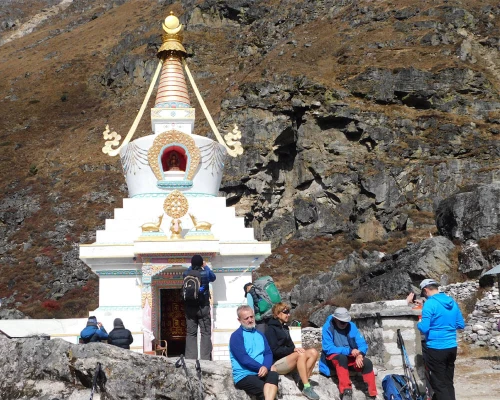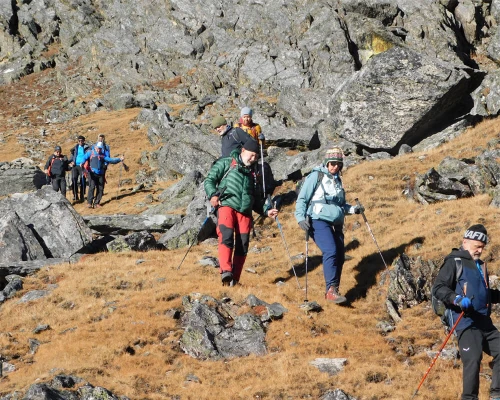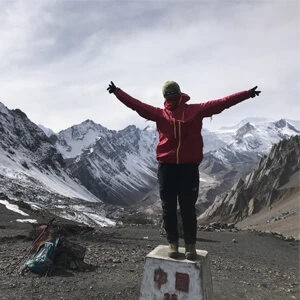Helambu Trek Overview
If you are searching for a quick vacation getaway from the hustle and bustle of city life to the stunning landscapes of the Himalayas, the Helambu Valley Trek is the perfect choice! This journey is a captivating adventure that unveils the pristine beauty and rich cultural heritage of Nepal’s Himalayas.
Perfectly suited for both seasoned and beginner trekkers, the 10 Day Helambu Trek will leave you in awe of its diverse terrain and intimate encounters with local cultures. During the journey, you will walk past stunning vistas, traditional villages, and serene high-altitude lakes, making it one of the most enchanting journeys.
Your adventure starts as soon as you land at the International Airport in Kathmandu. Your guide will be there to pick you up and transfer you to your hotel. The following day will be a complete rest day and you can take time to immerse yourself in Kathmandu's rich history and culture. In the meantime, your guide will also provide a quick overview of your journey, and you should also use this day to prepare for the adventure ahead.
The very next day, you will start your trek initially with a one-and-a-half-hour drive from Kathmandu to Sundarijal. This drive will provide you with the transition from urban vibrancy to natural beauty that will take you to the edge of the Shivalik Hills, which is the gateway to your trekking adventure.
Here, this initial stretch will set the stage for what’s to come, with rolling countryside and terraced fields framing your path. From Sundarijal, you will be on your feet towards Chisapani through the lush forests and terraced fields within the Shivapuri National Park. Even in the very first lap of your journey, you will feel the sudden change as you will find chirping birds, rustling leaves, and stone stairs throughout the trail.
During this hike, you will come across a few streams and waterfalls before you reach Mulkharka village, which will add a refreshing perspective to your trek. Once you reach the high ridge of Chisapani, you will be greeted with panoramic sunset views over the Kathmandu Valley and the distant peaks of the Himalayas. Some of the mountains you may see are Ganesh Himal, Langtang Himal, Gauri Shanker Himal, Dorje Lakpa, Ganchenpo, Jugal Himal, etc.
Ending and starting your day with the majestic overview of what is waiting for you ahead on the trail, you will make your way through charming local towns and terraced fields. This section of the trek takes you to Kutumsang which will give you a glimpse of the rural lifestyle of the locals in Chipling before again setting on the routes that take you through the lush forests.
From Kutumsang to Tharepati, the route is particularly scenic with breathtaking views of the Langtang range, Dorje Lakpa, and Gauri Shankar. Here onwards, you will start your journey within the Helambu territory. One thing to note during this section is the quick rise of altitude from 2,470 meters to 3,690 meters.
Soon, the surroundings will start getting more scenic with the diverse array of natural wonders. Even the landscapes will provide you with a blend of the spiritual, natural, and cultural mix of the region. As you walk through the fields and local villages, you will also get an opportunity to interact with the Hyolmo people and witness the lifestyle of the Sherpa and Tamang settlements once you reach Melamchi Gaun.
Through Tharepati to Tarke Gyang, the journey will generally be a descent to the lush verdant forest. At the same time, you will find the trails covered with mani walls, stupas, and monasteries, reflecting the local Buddhist practices. Your overnight stop at the Tarke Gyang is an incredible opportunity to explore the Himalayan landscapes and the local apple orchids.
Following it, you will also take an early morning hike to Ama Yangri View Point(3,371 meters) while you are in Tarke Gyang. This side trip offers 360-degree views of the Himalayan ranges.
Overall, from this point onward to Sermathang, the route is relatively easy. During this walk, you will pass Gyangul village which is nestled in the rolling hills. Here, Sermathang is a picturesque village and the home to an ancient monastery perched on a hill. This journey will pull you closer to the cultural aspect of the trek.
Altogether, the Helambu Valley Trek concludes at Sermanthang. Following it, you will make your way back to Kathmandu via bus.
So, whether you are drawn by the majestic mountain views, the peaceful monasteries, or the charming local towns, the Helambu Trek promises an unforgettable adventure that perfectly captures the essence of Nepal’s allure.
Langtang Helambu Trail Difficulty
The Langtang Helambu Trail is of moderate difficulty hence, even the beginner trekker with a reasonable level of fitness can embark on this journey. As a matter of fact, this culturally and naturally rich trek is ideal for adventurers who seek a challenge without venturing into the more strenuous high-altitude trails of Nepal.
During this trek, you will face varied terrain which may cause difficulties on the way. Most of this trek consists of steep ascents and descents particularly when traversing from village to village. Well, the initial phase of the trek is more physically demanding with the trails consisting of stone-paved stairs and rugged forested trails. Hence, this varying trail structure might pose a challenge in your trek.
On a similar note, the Helambu Valley Trek does not take you to an extreme altitude level, unlike other trails such as Everest Base Camp Trek, Everest Three High Passes Trek, Annapurna Circuit Trek, Manaslu Circuit Trek, etc. The maximum elevation level you will encounter is at Tharepati standing at an altitude of 3,690 meters (12,106 feet). Yet this altitude may give you mild symptoms of altitude sickness, such as headaches, shortness of breath, or fatigue, especially if you do not ascend gradually.
Additionally, you will have to trek for an average of 6 to 8 hours every day for a total of 6 days. Although the trek is generally moderate, the overall trekking hours can be daunting, especially on the steeper and more uneven sections of the trail. Therefore, if you do not have reasonable physical stamina and endurance, this trek might get demanding.
Overall, combining diverse terrain and significant altitude gain, the Helambu Short Trek is a physically engaging adventure. It does require proper preparation and fitness but is achievable even for those who are reasonably fit and prepared for a multi-day trek.
The Best Time To Trek In Helambu Region
The Helambu Region Trek is one of those journeys that caters to both first-time and avid trekkers. While this particular trek can be done all around the year, the Spring and Autumn seasons are the prime time that we recommend for a more comfortable and enjoyable journey. Having said that, each of the seasons brings its own set of beauty to this trekking trail.
The Autumn season from September to November is the best season you can embark this journey on. During this time of the year, you will get to enjoy relatively stable weather, crystal clear blue skies, chilly but not cold temperatures, and the biggest Nepalese festivals.
Typically, the daytime temperature on the trails of Helambu Tea House Trek during Autumn is around 10 to 20°C. However, the nighttime gets a bit chilly with the temperature around 5°C. Hence, you should dress up in layers and even carry a woolen cap that covers your head and ears at night.
Likewise, the Autumn season offers you optimal visibility and you will get to see the valley from a different perspective with its falling leaves and the color change in the surroundings. As a matter of fact, Autumn provides you with the best view of the Himalayan ranges as the weather is relatively predictable with no hints of clouds or fog in the sky.
Due to this very reason, it is also the best time for photography. Additionally, if you book your trip in October, you will get to witness and celebrate the biggest festivals of the Nepalese, Dashain and Tihar. However, the trekking trails during this season get a bit more crowded than in other seasons. Hence, if you are planning your trek this season, book your accommodation and transportation in advance to avoid any last-minute hassle.
Moving on to Spring, it starts in March and ends in May. This is another peak season for the trek as the trails start to breathe back to life after long and cold Winter sleep. Generally, the temperature during Spring is similar to that of Autumn, providing moderate and comfortable conditions to hike.
Furthermore, the days during Spring are much longer with fresh air and clear skies. During your trek, you will find trails covered in vibrant colors due to the rhododendron blooms and several other wildflowers along the way. Also, if you are lucky enough, you will witness wildlife such as Red Panda, Himalayan Tahr, Snow Leopards, White Monkeys, and Musk Deer to name a few.
Here, though Spring brings favorable trekking conditions, you should also be prepared for occasional rain and snowfall, especially during the start and the end of the season. Likewise, if you do not like crowded areas, you should rethink your trek’s timing.
After months-long favorable conditions, Spring is followed by the Monsoon / Summer season. From June to August, you will experience heavy rainfall throughout this region which makes the trek a bit gloomy for many.
With dark rain-filled clouds and limited visibility, this season also brings an abundance of leeches all along the trail. During most of this season, the trail gets muddy and slippery, making it difficult to accomplish. However, the days remain hot and humid with the temperature ranging between 20 to 30 °C.
In the meantime, this heavy downpour increases the risk of landslides and blocked roads in the lower region, creating a delay in your schedule at times. However, if you can stick to these challenges of the Monsoon season, you will be rewarded with fewer crowds and a fresh environment at its peak.
Last but not least, the Winter season in Helambu Tea House Trek starts in December and ends in February. This particular season brings freezing cold with daytime temperatures around 6°C-15°C.and the nighttime temperature dropping up to -15°C.
Furthermore, the Winter season covers the trail with snow and ice, making the path slippery and difficult to trek in. However, with careful planning and proper preparation, the journey is still doable though we do not recommend it to beginner trekkers. Similar to the Monsoon season, if you are able to stick through the season, you will witness the trails in a fairytale-themed world - all white and covered in snow! Furthermore, you will also find solitude on the trail.
Permits For Helambu Hiking Adventure
To embark on the Helambu Hiking Adventure, you will require a total of three permits; the Langtang National Park Entry Permit, the Shivapuri National Park Entry Permit, and the Trekkers' Information Management System (TIMS) Card. All these permits hold a specific purpose on your trek, ensuring a smooth journey through the protected areas.
As the Helambu Ridge Hike will take you within the Langtang National Park, you will require an entry permit which will cost you NRs 3,000. Likewise, during the starting point of the trek, since you will walk through the Shivapuri National Park, you will also need its entry permit which is around NRs 500. Lastly, you will need the Trekkers' Information Management System (TIMS) Card, which is NRs 2,000.
Altogether, you can get these permits from the Nepal Tourism Board office in Kathmandu. Otherwise, you can also get it through your local trekking agency. For these, you will need a valid passport and a pair of passport-size pictures.
Booking And Payment With Nepal Trekking Experts
To book your trek with us, you have to send a deposit of 10% of the total cost of the trek. Please also forward a copy of your passport, a passport-sized photo, and full flight details if and when available. For your convenience, you may also forward the deposit to us online through our website. It is completely safe, and as soon as you make it, you will get an automatic receipt in your inbox. The rest of the payment can be paid upon arrival.
If you have any questions, do not hesitate to contact us anytime. We are always ready to assist.








 based on 12 reviews
based on 12 reviews



